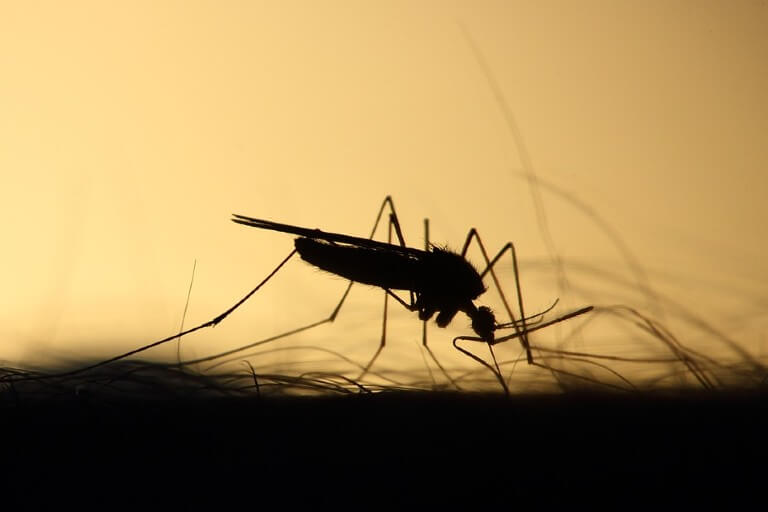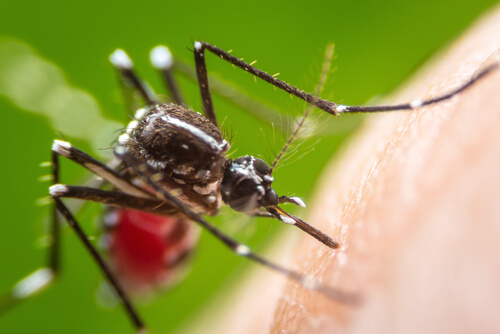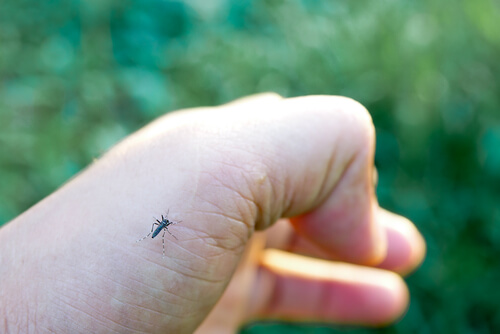Find Out Why Mosquitoes Bite Some People More than Others

Mosquitoes are so tiny that they often go unnoticed. However, they’re well known for feeding on people’s blood, so if we don’t spot them we’ll have to suffer the consequences – discomfort and a lot of itching. Of course, mosquitoes bite some people more than others, and not everyone suffers equally from mosquito bites.
Although it may seem strange, mosquitoes select their prey by certain biological characteristics. This is the reason why some people have a certain tendency to be bitten. Read on to find out why mosquitoes bite some people and not others.
What are mosquitoes?
Mosquitoes are a type of small invertebrate belonging to the dipteran group (di=two, pteros=wings). Their bodies measure, on average, between 3 and 6 millimeters (0.1 to 0.2 inches) long and is divided into 3 sections: the head, the thorax and the abdomen. In addition, as their name suggests, they have two well-defined wings which help them to fly easily.
Contrary to what one might think, only female mosquitoes have a hematophagous diet. For this purpose, they have a modified mouth called a proboscis, which has an elongated appearance and can penetrate skin. Thanks to this, they use their mouth as a “straw” and suck the blood of their prey.
Females need to consume blood because it contains proteins that are essential for the development of their eggs. In fact, most species lay their eggs right after feeding, as they immediately take advantage of the nutrients. Of course, their size doesn’t allow them to suck too much, but 2 or 3 milligrams of blood is enough to lay up to 100 eggs.

How do mosquitoes choose who to bite?
While it’s true that mosquitoes have a series of compound eyes that allow them to see their surroundings, they don’t use this sense to select their victims. In general, these insects are guided by the smells perceived by their antennae, which tell them who is the most attractive prey.
Specifically, mosquitoes are attracted to pheromones, carbon dioxide, lactic acid, ammonium, estradiol, and other substances that are a product of animal metabolism. Most of these molecules accumulate on the skin in varying amounts, which generates a characteristic odor unique to each individual.
The involvement of CO₂ in attracting mosquitoes
Mosquitoes detect their prey through carbon dioxide (CO₂), as people emit this compound after breathing (exhalation). This tells the insects the path they must follow to get their food, although it isn’t the only determinant in who they bite. Viewed another way, it serves as a type of initial signal that travels through the air and indicates the presence of prey.
There are some studies that indicate that the amount of CO₂ emitted by a person is decisive in whether or not mosquitoes are attracted. However, this doesn’t guarantee that they will all bite the same people. Therefore, it appears that mosquitoes take other factors into account in deciding whether or not to bite a person.
The involvement of lactic acid in attracting mosquitoes
Lactic acid secreted in sweat is one of the main mosquito attractants. This compound is a product of the normal metabolism of epithelial cells and is therefore present throughout the skin. However, the amount of lactic acid secreted by the body varies according to the density of sweat glands a person has.
This means that the more sweat glands, the more likely a person is to be bitten by mosquitoes. The only problem is that the density of these glands is highly dependent on as-yet undetermined genetic factors.

Substances that affect people’s odor
A person’s odor is the product of a large combination of substances found on the skin. In fact, it’s estimated that at least 400 different molecules are involved, the most important of which are carboxylic acids, aromatic hydrocarbons, esters, ketones, and sulfides.
The attraction of mosquitoes to certain people is often explained by the difference in their odors. However, it has been shown on different occasions that this premise isn’t entirely correct, as each mosquito species seems to have its own preferences.
In Aedes aegypti mosquitoes, a greater attraction to African Americans than to Caucasians or Asians has been observed. On the other hand, the species Anpheles albimanus showed a greater preference for adults than for children. As can be guessed, each mosquito species is attracted to certain odors, which makes it even more complicated to identify what makes them choose who they bite.
Not everything is metabolism
Metabolism isn’t the only factor involved in generating the particular odor of each person. There are certain microorganisms that live naturally on the skin, which can cause certain substances to modify and change their scent. This can also prove to be an essential factor in mosquito bites, although it’s somewhat difficult to measure the impact it has on their decision.
In fact, when suffering from an illness, the population of microorganisms on the skin can be modified and change the person’s odor temporarily. Consequently, the probability of mosquitoes biting may decrease or increase, although it all depends on the pathological process.
As you can see, it’s difficult to identify the components that cause mosquitoes to bite any given person more, as they change according to the species. Since this is a controversial topic, there’s still a long way to go to reach a conclusion and create better ways of preventing mosquito bites.
All cited sources were thoroughly reviewed by our team to ensure their quality, reliability, currency, and validity. The bibliography of this article was considered reliable and of academic or scientific accuracy.
- Ruiz, N., Rincón, G. A., Parra, H. J., & Duque, J. E. (2018). Dinámica de oviposición de Aedes (Stegomyia) aegypti (Diptera: Culicidae), estado gonadotrófico y coexistencia con otros culícidos en el área Metropolitana de Bucaramanga, Colombia. Revista de la Universidad Industrial de Santander. Salud, 50(4), 308-319.
- Torres-Estrada, J. L., & Rodríguez, M. H. (2003). Señales físico químicas involucradas en la búsqueda de hospederos y en la inducción de picadura por mosquitos. Salud pública de México, 45(6), 497-505.
- Zhang, H., Zhu, Y., Liu, Z., Peng, Y., Peng, W., Tong, L., … & Cheng, G. (2022). A volatile from the skin microbiota of flavivirus-infected hosts promotes mosquito attractiveness. Cell, 185(14), 2510-2522.
- Téllez, E. A. R. (2005). Human body odor, mosquito bites and the risk of disease transmission. Folia Entomologica Mexicana, 44(2), 247-265.
